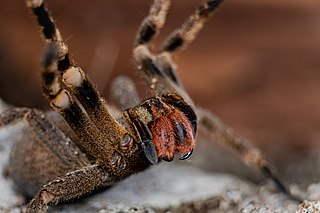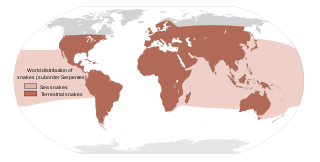
Venom or zootoxin is a type of toxin produced by an animal that is actively delivered through a wound by means of a bite, sting, or similar action. The toxin is delivered through a specially evolved venom apparatus, such as fangs or a stinger, in a process called envenomation. Venom is often distinguished from poison, which is a toxin that is passively delivered by being ingested, inhaled, or absorbed through the skin, and toxungen, which is actively transferred to the external surface of another animal via a physical delivery mechanism.

Antivenom, also known as antivenin, venom antiserum, and antivenom immunoglobulin, is a specific treatment for envenomation. It is composed of antibodies and used to treat certain venomous bites and stings. Antivenoms are recommended only if there is significant toxicity or a high risk of toxicity. The specific antivenom needed depends on the species involved. It is given by injection.

A snakebite is an injury caused by the bite of a snake, especially a venomous snake. A common sign of a bite from a venomous snake is the presence of two puncture wounds from the animal's fangs. Sometimes venom injection from the bite may occur. This may result in redness, swelling, and severe pain at the area, which may take up to an hour to appear. Vomiting, blurred vision, tingling of the limbs, and sweating may result. Most bites are on the hands, arms, or legs. Fear following a bite is common with symptoms of a racing heart and feeling faint. The venom may cause bleeding, kidney failure, a severe allergic reaction, tissue death around the bite, or breathing problems. Bites may result in the loss of a limb or other chronic problems or even death.

The inland taipan, also commonly known as the western taipan, the small-scaled snake or the fierce snake, is a species of extremely venomous snake in the family Elapidae. The species is endemic to semi-arid regions of central east Australia. Aboriginal Australians living in those regions named the snake dandarabilla. It was formally described by Frederick McCoy in 1879 and then by William John Macleay in 1882, but for the next 90 years it was a mystery to the scientific community; no further specimens were found, and virtually nothing was added to the knowledge of this species until its rediscovery in 1972.
A snake-stone, also known as a viper's stone, snake's pearl, black stone, serpent-stone, or nagamani is an animal bone or stone used as folk medicine for snake bite in Africa, South America, India and Asia.

The monocled cobra, also called monocellate cobra and Indian spitting cobra, is a venomous cobra species widespread across South and Southeast Asia and listed as Least Concern on the IUCN Red List.

The Caspian cobra, also called the Central Asian cobra, ladle snake, Oxus cobra, or Russian cobra, is a species of venomous snake in the family Elapidae. The species is endemic to Central Asia. Described by Karl Eichwald in 1831, it was for many years considered a subspecies of the Indian cobra until genetic analysis revealed it to be a distinct species.

Pseudonaja is a genus of highly venomous elapid snakes native to Australia. Species of this genus are known commonly as brown snakes and are considered to be some of the most dangerous snakes in the world; even young snakes are capable of delivering a fatal envenomation to a human.

Naja is a genus of venomous elapid snakes commonly known as cobras. Members of the genus Naja are the most widespread and the most widely recognized as "true" cobras. Various species occur in regions throughout Africa, Southwest Asia, South Asia, and Southeast Asia. Several other elapid species are also called "cobras", such as the king cobra and the rinkhals, but neither are true cobras, in that they do not belong to the genus Naja, but instead each belong to monotypic genera Hemachatus and Ophiophagus.

Phoneutria nigriventer is a species of medically significant spider in the family Ctenidae, found in the Southern Cone of South America. Along with other members of the genus, they are often referred to as Brazilian wandering spiders.
Venom-induced consumption coagulopathy (VICC) is a medical condition caused by the effects of some snake and caterpillar venoms on the blood. Important coagulation factors are activated by the specific serine proteases in the venom and as they become exhausted, coagulopathy develops. Symptoms are consistent with uncontrolled bleeding. Diagnosis is made using blood tests that assess clotting ability along with recent history of envenomation. Treatment generally involves pressure dressing, confirmatory blood testing, and antivenom administration.

The coastal taipan, or common taipan, is a species of highly venomous snake in the family Elapidae. Described by Wilhelm Peters in 1867, the species is native to the coastal regions of northern and eastern Australia and the island of New Guinea. The second-longest venomous snake in Australia, the coastal taipan averages around 2 m (6.6 ft) long, with the longest specimens reaching 2.9 m (9.5 ft) in length. It has light olive or reddish-brown upperparts, with paler underparts. The snake is considered to be a least-concern species according to the International Union for Conservation of Nature.

Most snakebites are caused by non-venomous snakes. Of the roughly 3,700 known species of snake found worldwide, only 15% are considered dangerous to humans. Snakes are found on every continent except Antarctica. There are two major families of venomous snakes, Elapidae and Viperidae. Three hundred twenty five species in 61 genera are recognized in the family Elapidae and 224 species in 22 genera are recognized in the family Viperidae, In addition, the most diverse and widely distributed snake family, the colubrids, has approximately 700 venomous species, but only five genera—boomslangs, twig snakes, keelback snakes, green snakes, and slender snakes—have caused human fatalities.
Findlay Ewing Russell was an American internal medicine physician and toxicologist. He pursued a research interest in venomous and poisonous animals and the effects of toxins on the human nervous system and was widely acknowledged as one of the world's leading authorities on snakes and the pharmacology of snake venoms. Consulting work for the United Nations and various governmental agencies took him all over the world.
International Society on Toxinology (IST) is a global society of scientists and clinicians working for the advancement of venoms, poisons and toxins. It was founded in 1962 with an aim to advance knowledge on venoms, poisons and toxins of animal, plant and microbial origin.
Redi Award is an international science award given to scientists who have made significant contributions in toxinology, the scientific study of venoms, poisons and toxins. The award is sponsored by the International Society on Toxinology (ISI).

Steven A. Seifert was an American medical toxicologist. He was a professor of emergency medicine at the University of New Mexico, as well as the medical director of the New Mexico Poison and Drug Information Center. Since 2017, he was the editor-in-chief of Clinical Toxicology. He was also a jazz tenor saxophonist.
Sean Paul Bush is an American emergency physician, academic, and researcher. An expert on venomous bites and stings, he was a host of the Animal Planet series, Venom ER. He is the current President of the North American Society of Toxinology.

Hemiscolopendra marginata, the eastern bark centipede, is a common species of centipede found in the Eastern United States and parts of Mexico. H. marginata is the first centipede species shown to exhibit sexual dimorphism in venom composition.













